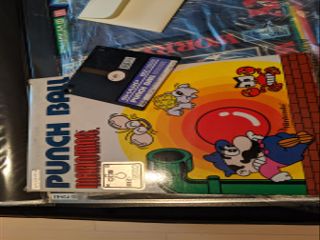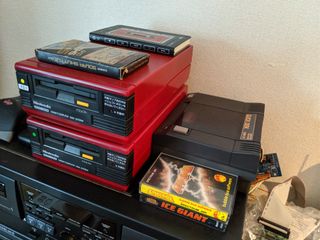In this bizarre '80s Mario Bros. PC port, Mario throws a ball, badly
It's hard to understand why Punch Ball Mario Bros. exists, and why Mario throws a dinky ball instead of using his signature jump.

Mario jumps on things. There are maybe three or four Laws of Mario, and that's one of them. Mario jumps on top of things to kill them, or he jumps into a block from below to flip them over. Other Mario Laws include: Mario has a mustache. Mario gets big when he eats a mushroom. Mario wears overalls (this is maybe not a Mario Law, as he wears many non-overall outfits in Mario Odyssey). Nintendo is strict about enforcing the Mario Laws, except in rare cases, like the infamously weird '90s PC educational games. But way before those weird licensed spin-offs, Mario made his PC debut in a game that breaks the very first rule of Mario. He punches things. With a ball.
Yes, this is messed up. Mario's nickname is Jumpman, not Punchman. But in 1984, before Super Mario Bros. defined Mario as we know him today, Nintendo apparently wasn't so protective of the Mario Laws, and it handed publisher Hudson the rights to make a Mario Bros. arcade port for the then-popular PC-8801. And it is very weird.
"If you look at it, it's just like the original Mario Bros., you're just adding a punch ball," says Joseph Redon, the founder of the Japanese Game Preservation Society, which is focused on collecting these sorts of PC oddities. "You throw the ball to hit enemies. Maybe they thought it was a good idea at Hudson, or maybe they had a project at Nintendo but scrapped it for the Famicom, and Hudson said okay, we will release it for PC," he speculates.
As I learn from Redon, Hudson released hundreds of games at its peak, and at the time it was a major publisher in the Japanese PC space. Maybe that's why Nintendo, which had just released the Famicom, gave Hudson the rights to make a couple Mario ports for PCs (including the PC-88, Sharp X1, and other popular '80s systems. There were a bunch of them).
What's hard to understand about Punch Ball Mario Bros. is: Why. Why is it? Why, in recreating the popular arcade Mario Bros. game for PC, did Hudson decide to give him a ball to throw at koopas, when the whole jumping thing worked pretty well?
Like many questionable PC ports of the era, the movement speed and jumping are a little off, a little too fast. And the weirdest thing about the punch ball is that Mario doesn't even throw it. He kinda, just... lets it flop out of his hand, like Citizen Kane dropping his snowglobe. The enemies move faster than the ball! It's like he knew this whole thing was bullshit.
I'm not positive, but I believe Punch Ball Mario Bros. bears the honor of being the very first licensed Mario game. Maybe even the first licensed Nintendo game, period? That's hard to to confirm, but it's at least one of the earliest, and it's honestly kind of a wonder Nintendo ever licensed Mario out for PC games again. I hope I have the opportunity to interview Shigeru Miyamoto someday, just to ask him what he thinks of Punch Ball Mario Bros.
The biggest gaming news, reviews and hardware deals
Keep up to date with the most important stories and the best deals, as picked by the PC Gamer team.

One other fun factoid about this game: One of the systems it was released for, the Sharp MZ-1500, used an obscure format called the Quick Disk, a small 2.8-inch disk. And the Quick Disk actually used the same hardware as the Famicom Disk System, never released in the US but briefly popular in Japan. It brought some advantages that early Famicom games didn't have, including cheaper games, more storage and the ability to save games. If you had a Quick Disk drive in the '80s, you could actually buy an adapter to make Nintendo's disks fit in the drive and then make copies of Famicom Disk System games.
Maybe Nintendo felt burned by Quick Disk piracy, and that's why its major games essentially never showed up on PCs again. Or maybe Miyamoto played Punch Ball Mario Bros., scratched his head, mumbled "What the hell?" and decided it was time to codify Mario Law.

Wes has been covering games and hardware for more than 10 years, first at tech sites like The Wirecutter and Tested before joining the PC Gamer team in 2014. Wes plays a little bit of everything, but he'll always jump at the chance to cover emulation and Japanese games.
When he's not obsessively optimizing and re-optimizing a tangle of conveyor belts in Satisfactory (it's really becoming a problem), he's probably playing a 20-year-old Final Fantasy or some opaque ASCII roguelike. With a focus on writing and editing features, he seeks out personal stories and in-depth histories from the corners of PC gaming and its niche communities. 50% pizza by volume (deep dish, to be specific).
Most Popular


